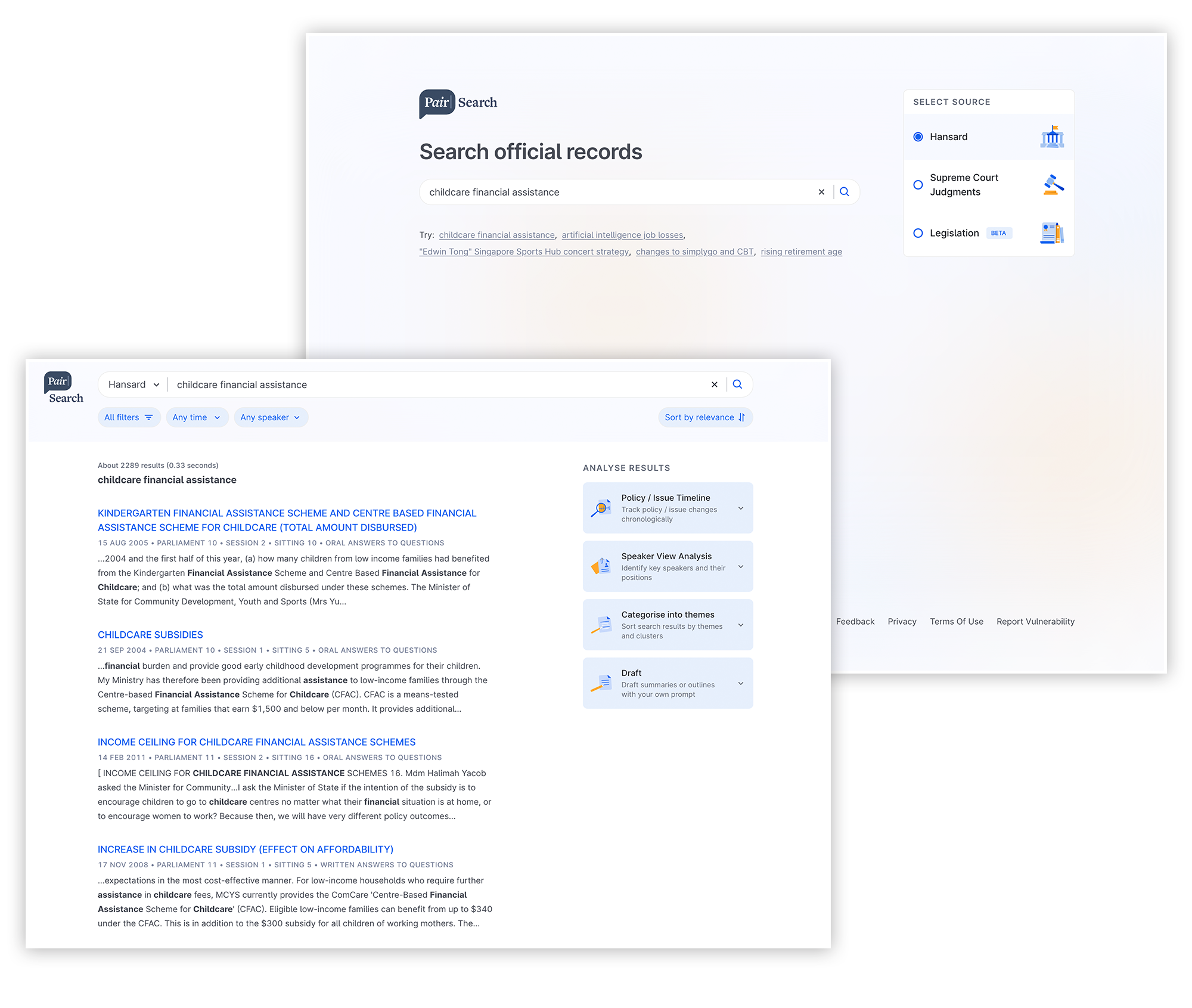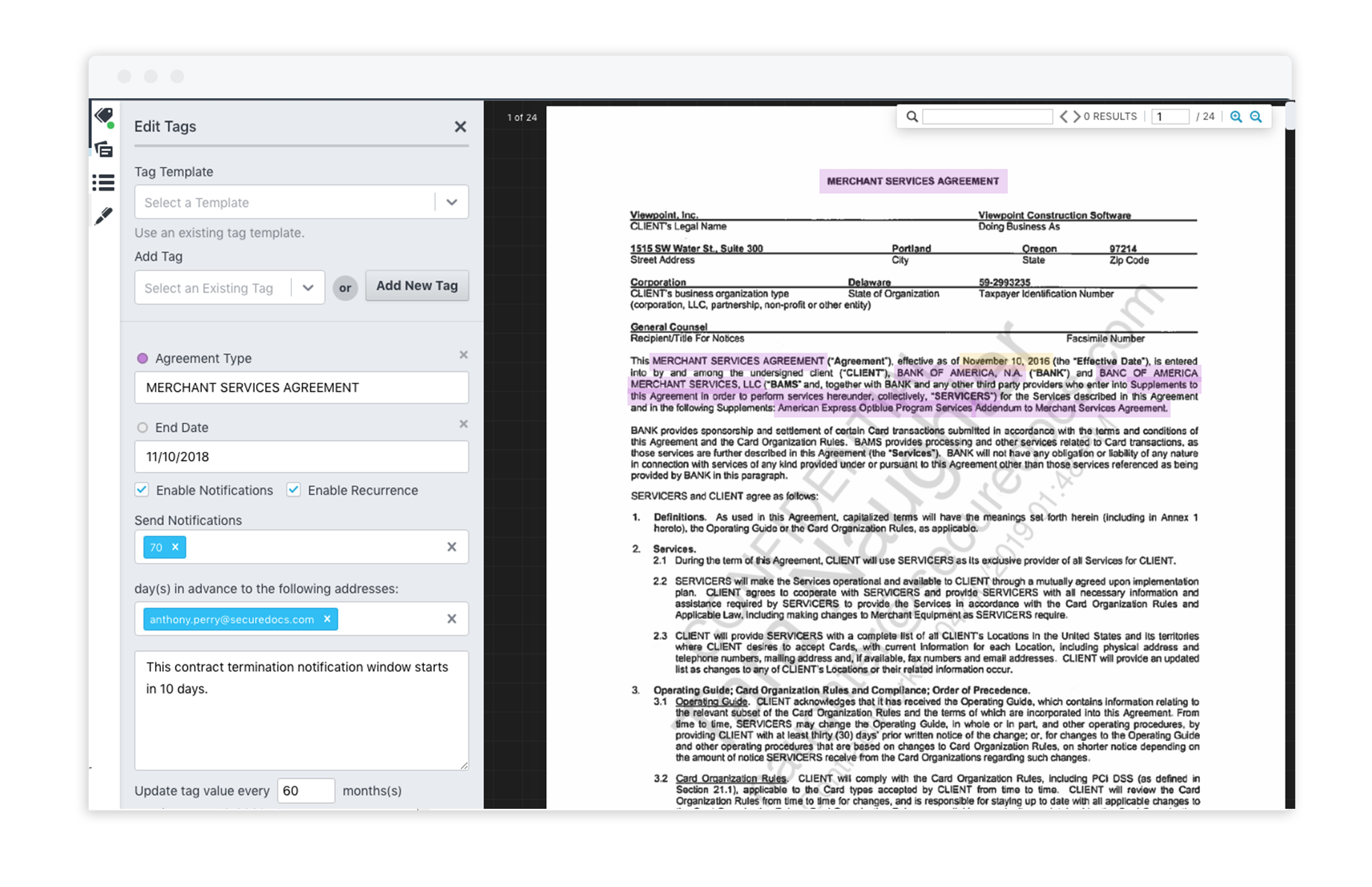Note: This chapter is intended for government agencies with an intermediate to advanced level of organizational maturity. We recognize that adopting new technology and changing internal systems requires long-term planning. We hope that this chapter serves as guidance on the potential of this adoption to plan for the next stage of your journey.
Overview
Civil servants need to reference multiple files, review historical records, and stay updated on the latest policies and regulations. One of the methods to make these processes more efficient is by integrating a GenAI tool into their knowledge management system. GenAI-assisted knowledge management tools allow people to quickly search, summarize, and extract key insights from vast amounts of information, making it easier to draft reports, ensure compliance, and make informed decisions faster. This section highlights common features of a GenAI-assisted knowledge management system, helping civil servants understand its potential and evaluate whether it’s the right fit for their department.
How a GenAI-assisted Knowledge Management System Works
Knowledge management is the process of capturing, organizing, and sharing knowledge within an organization to improve efficiency and decision-making. In a government context, this means ensuring that policies, regulations, and institutional practices are easy for civil servants to access.
Knowledge management systems are platforms that help with this process. They typically include features like document storage, searchable databases, collaboration tools, and workflows, designed to help employees find and share the right information quickly. A GenAI-assisted knowledge management system uses GenAI to analyze content, answer questions, and identify future needs based on user behavior. Additionally, it can pull up-to-date information from reputable sources, helping departments stay current with the latest policies and document updates. This makes the system more dynamic, interactive, and responsive to user needs. To learn more about how GenAI works in a knowledge management system, visit datos.gob.es, which explains the techniques in an LLM model that allows these systems to retrieve the latest information.
Applying This Tip
Depending on its design and purpose, a GenAI-assisted knowledge management system can be developed for public-facing use with publicly available information, internal use with sensitive data, or a combination of both.
Implementing an internal GenAI-assisted knowledge management system in government agencies is a long-term process to meet legal, regulatory, and data protection requirements. Security and privacy controls are especially important for government agencies handling sensitive or classified information to protect against cybersecurity risks (IPA, 2020).
However, many governments are implementing digital transformation plans to make data and information more accessible across departments, improving service delivery, decision-making, and governance. GenAI-assisted knowledge management systems are tools that can support improving government operations. The following section helps civil servants better understand the capabilities of a GenAI-assisted knowledge management system.
Find Documents Faster
A GenAI-assisted knowledge management system enables faster document retrieval, especially for older files. For the latter, instead of relying on exact file names, you can search by keywords or topics and the system will identify relevant documents based on their content. You could ask, “Where can I find the budget template for departmental funding requests?” This is particularly useful after transitioning to a new file naming system or when the document name is unknown. By analyzing document content rather than just file names, important information remains easy to find regardless of how it was originally stored. An example of this is Singapore’s Pair Search, a search tool designed for civil servants that uses GenAI to quickly find and retrieve relevant government documents, laws, and policy papers.

Generative AI Use Case
Grants Program Administration with a GenAI-assisted Knowledge Management System
The United States’ National Telecommunications and Information Administration is exploring the use of a GenAI-assisted knowledge management system for its internal grant program administration team. While specific focus areas have not been disclosed, potential applications could include evaluating the effectiveness of GenAI-assisted document search and retrieval to efficiently locate relevant grant documents and policies (U.S. Department of Commerce, 2024). For example, the internal team could ask, “Find all broadband infrastructure applications submitted in Q2 2023” to generate a list of relevant documents. Additionally, AI-assisted systems are especially useful in providing comprehensive document summaries, as they condense jargon-filled or highly technical documents into key points, minimizing the user’s need to read through entire files. For instance, a user could input “Summarize 2024 compliance requirements for federally funded telecommunications projects” and receive a concise overview of policies and deadlines. These small time saving practices can significantly improve grant administration workflows as well as enable staff to quickly access relevant information during meetings for faster and more informed decision making.
Disclaimer: The mention of the United States’ National Telecommunications and Information Administration does not imply or constitute any endorsement.
In certain cases, documents may be classified or not digitized, leaving them out of this knowledge management system. The security considerations for government documents come into effect here and may require using old archival systems along with a new Gen AI- assisted knowledge management system.
Organize Documents
A GenAI tool can make organizing files easier by automatically tagging documents based on their content. Users can create a custom tag list first, then the system will scan documents for key concepts and keywords to either recommend relevant tags or automatically assign tags based on previous tagging patterns. Paired with your file naming system, this adds another layer of organization agency-wide. One example of this feature is Google Drive’s AI classification for automatically labeling documents with an AI Security add-on.

Generative AI Use Case
Auto Tag Financial Reports
In this fictional scenario, a Senior Policy Advisor at the United Kingdom’s HM Treasury’s Budget and Public Spending Division manages various financial reports, budget submissions, and spending reviews. A GenAI tool can streamline document organization by automatically tagging files based on key concepts like department, fiscal year, and document type, making retrieval faster and more consistent.
Disclaimer: The mention of the United Kingdom’s HM Treasury’s Budget and Public Spending Division does not imply or constitute any endorsement.
Track Updates
With a GenAI tool integrated into your knowledge management system, you can retrieve information from your documents using conversational language. With parliamentary policy debates being updated regularly, the GenAI tool can help civil servants quickly access clear and up-to-date summaries. For example, you can ask, “Show all recent updates to [relevant policy]?” and the system will search your documents, summarize the relevant information, and provide the source document, reducing the time spent manually searching for the correct document. You can also compare different document files with generated summaries to view the changes. For more advanced features like real-time updates, alerts require developer assistance. Some software that offers built-in notifications is Google Vertex AI Search or IBM watsonx Assistant.
Generative AI Use Case
Track Latest Updates to Funding Allocations
In this fictional scenario, the Program Manager at Canada’s Mortgage and Housing Corporation (CMHC) is responsible for overseeing funding allocations and tracking policy updates related to the annual budget and updates to Canada’s Housing Plan. Each year, procurement solicitations, budget reports, and policy documents are updated to reflect changes to funding and program priorities. Using a GenAI-assisted knowledge management system allows the Program Manager to ask “Compare the 2022 and 2023 procurement solicitations for affordable housing initiatives, then summarize changes made” and “What are the 2024 budget allocations for affordable housing programs in Canada?”. This helps the Program Manager identify shifts in funding and track past procurement solicitation changes. With this information, the Program Manager can adjust the 2024 procurement solicitation process to ensure funding aligns with the policy priorities.
Disclaimer: The mention of Canada’s Mortgage and Housing Corporation does not imply or constitute any endorsement.
Prompt Examples and Uses
Use this guide as a cheat sheet for testing how a GenAI-assisted knowledge management system can help with file search, summarization, content analysis, and policy checks. You can use these examples to interact with your system.
| Use Cases | Prompt Examples |
|---|---|
| File Search | “Find all documents related to [topic keyword]” “Locate the latest version of [document name]” “Identify duplicate documents related to [topic keyword]” “Does the system have any documents on [emerging trend or topic keywords]?” |
| Summaries & Synthesis | “Summarize key insights from reports on [subject] over the last [timeframe]” “Summarize all action items from meeting notes in [document name]” “Provide a 200 word summary of all files related to [topic keyword]” |
| Content Analysis | “Identify trends across annual reports from [year range]” “Provide recommendations based on past reports on [initiative name]” “ Compare and contrast findings from these three documents: [file 1], [file 2], [file 3]” |
| Compliance & Policy Checks | “What are the best practices for [topic keyword] according to our internal documents?” “Summarize the key regulatory changes from our policy updates” |
Considerations for Using a GenAI Knowledge Management System
To get a better understanding of the capabilities of a knowledge management system, you could simulate some of these features using a personal document management system with an embedded GenAI tool, such as Google Gemini, within your drive.
To pilot a GenAI tool within your knowledge management system, you can begin by researching if another government department is piloting a GenAI tool or if your government has a list of verified suppliers. For example, the Canadian Government established a list of pre-qualified suppliers to streamline the procurement process to obtain AI solutions. If you’d like to learn more about trialing a GenAI tool, discuss with your division leader about potential informal use or a trial period to assess its suitability.
The process of introducing new technologies in government usually starts with trialing the tool to better understand how it might support your departmental needs. Each option would have different risk levels and setup requirements, so the choice depends on data sensitivity, security needs, and approval processes within your department. The U.S. Office of Personnel Management has a helpful guide that outlines the major steps for organizational leaders to consider when designing and developing a Knowledge Management Program appropriate for their organization.
Finally, below are questions to consider when deciding if a GenAI-assisted knowledge management system is the right fit for your department.
- What types of documents or information do you frequently search for that take significant time to locate?
- What key challenges in your current knowledge management system can GenAI help address?
- Who would need to be involved depending on the scope of your testing?
- How will AI integrate with existing government systems and databases?
- How large is the database you are considering for the implementation of a GenAI-assisted Knowledge Management System?
- Do you imagine the database growing significantly?
- What kind of document organization features would be most helpful?
- Does the GenAI tool comply with government data security and privacy regulations?
- How will the tool handle classified, sensitive, or personally identifiable information (PII)?
- How can your department best prepare for the infrastructure, training, and workflow adjustments that come with implementing an advanced AI system?
- How will AI integration scale over time as knowledge and regulatory requirements evolve?
Do not hesitate to consider a phased or incremental approach to help ensure a smoother transition to utilizing a new tool or system.
Sources
-
U.S. Department of Commerce. (2024). Artificial Intelligence Use Cases Inventory. Retrieved from https://www.commerce.gov/about/policies/artificial-intelligence-use-cases-inventory
-
The Institute of Public Administration. (April, 2020). Knowledge management lessons for local government. Retrieved from https://www.ipa.ie/_fileUpload/Documents/Knowledge_Management_Lesson_%20for_Local_Government.pdf
-
U.S. Office of Personnel Management. (September, 2005). Leveraging Knowledge Capital. Retrieved from https://www.opm.gov/policy-data-oversight/human-capital-framework/reference-materials/leadership-knowledge-management/leveragingknowledge.pdf